Outmigration Drives Cropland Decline and Woodland Increase in Rural Regions of Southwest China
Abstract
1. Introduction
2. Study Area, Data and Methodology
2.1. Study Area
2.2. Data Sources and Images Pre-Processing
2.3. Research Methods
2.3.1. LULC Classification and Transition Detection Matrix
2.3.2. NDVI Trend Detection Based on Various Methods
2.3.3. Integrated Analysis of LULC Conversions and NDVI Dynamics
3. Results
3.1. LULC Maps and Transition Matrices
3.2. Vegetation Changing Trend Analysis Based on NDVI
3.3. Contribution of LUCC to NDVI Dynamics
4. Discussion
4.1. Dynamics in Each LULC Type and Driving Mechanisms
4.2. NDVI Changing Trends and Drivers
4.3. Implications for the Rural Development in Southwest China
4.4. Future Research Perspectives
5. Conclusions
Author Contributions
Funding
Acknowledgments
Conflicts of Interest
References
- Carmona, A.; Nahuelhual, L.; Echeverría, C.; Báez, A. Linking farming systems to landscape change: An empirical and spatially explicit study in southern Chile. Agric. Ecosyst. Environ. 2010, 139, 40–50. [Google Scholar] [CrossRef]
- Haddaway, N.R.; Styles, D.; Pullin, A.S. Environmental impacts of farm land abandonment in high altitude/mountain regions: A systematic map of the evidence. Environ. Evid. 2013, 2, 18. [Google Scholar] [CrossRef]
- Li, Y.; Cao, Z.; Long, H.; Liu, Y.; Li, W. Dynamic analysis of ecological environment combined with land cover and NDVI changes and implications for sustainable urban–rural development: The case of Mu Us Sandy Land, China. J. Clean. Prod. 2017, 142, 697–715. [Google Scholar] [CrossRef]
- Maimaitijiang, M.; Ghulam, A.; Sandoval, J.O.; Maimaitiyiming, M. Drivers of land cover and land use changes in St. Louis metropolitan area over the past 40 years characterized by remote sensing and census population data. Int. J. Appl. Earth. Obs. Geoinf. 2015, 35, 161–174. [Google Scholar] [CrossRef]
- Farmland Preservation in China. Available online: https://www.lincolninst.edu/publications/articles/farmland-preservation-china#:~:text=China’s%20rate%20of%20per%20capita,percent%20of%20the%20world’s%20farmland (accessed on 15 June 2020).
- Population, Total-China. Available online: https://data.worldbank.org/indicator/SP.POP.TOTL?locations=CN (accessed on 2 December 2019).
- Wang, Y.; Xin, L.; Zhang, H.; Li, Y. An estimation of the extent of rent-free farmland transfer and its driving forces in rural china: A multilevel logit model analysis. Sustainability 2019, 11, 3161. [Google Scholar] [CrossRef]
- Wang, Y.; Li, X.; He, H.; Xin, L.; Tan, M. How reliable are cultivated land assets as social security for Chinese farmers? Land Use Policy 2020, 90, 104318. [Google Scholar] [CrossRef]
- Liu, Z.; Gu, H. Evolution characteristics of spatial concentration patterns of interprovincial population migration in China from 1985 to 2015. Appl. Spat. Anal. Policy 2020, 13, 375–391. [Google Scholar] [CrossRef]
- Su, Y.; Tesfazion, P.; Zhao, Z. Where are the migrants from? Inter-vs. intra-provincial rural-urban migration in China. China Econ. Rev. 2018, 47, 142–155. [Google Scholar] [CrossRef]
- Statistical Communiqué of the People’s Republic of China on the 2017 National Economic and Social Development. Available online: http://www.stats.gov.cn/english/PressRelease/201802/t20180228_1585666.html (accessed on 30 September 2019).
- Chen, R.; Ye, C.; Cai, Y.; Xing, X.; Chen, Q. The impact of rural out-migration on land use transition in China: Past, present and trend. Land Use Policy 2014, 40, 101–110. [Google Scholar] [CrossRef]
- Li, S.; Li, X.; Sun, L.; Cao, G.; Fischer, G.; Tramberend, S. An estimation of the extent of cropland abandonment in mountainous regions of China. Land Degrad. Dev. 2018, 29, 1327–1342. [Google Scholar] [CrossRef]
- Li, Y.; Jia, L.; Wu, W.; Yan, J.; Liu, Y. Urbanization for rural sustainability–Rethinking China’s urbanization strategy. J. Clean. Prod. 2018, 178, 580–586. [Google Scholar] [CrossRef]
- Wang, Q.; Zhang, X. Three rights separation: China’s proposed rural land rights reform and four types of local trials. Land Use Policy 2017, 63, 111–121. [Google Scholar] [CrossRef]
- Xu, J. Migrant Workers Reached 221 Million, Family Migration is Dominant. (In Chinese). Available online: http://china.caixin.com/2011-03-03/100231784.html (accessed on 25 October 2020).
- Urbanization. Available online: https://ourworldindata.org/urbanization (accessed on 5 October 2019).
- Long, H.; Li, Y.; Liu, Y.; Woods, M.; Zou, J. Accelerated restructuring in rural China fueled by ‘increasing vs. decreasing balance’land-use policy for dealing with hollowed villages. Land Use Policy 2012, 29, 11–22. [Google Scholar] [CrossRef]
- China Statistical Yearbook. Available online: http://www.stats.gov.cn/tjsj/ndsj/ (accessed on 3 May 2020).
- Xinhua. Across China: Young Farmers Grow Success in Villages. Available online: http://www.xinhuanet.com/english/2019-07/18/c_138236723.htm#:~:text=China%20has%20an%20aging%20farming,for%20more%20than%2025%20percent (accessed on 25 October 2020).
- Yang, X.J. China’s rapid urbanization. Science 2013, 342, 310. [Google Scholar] [CrossRef] [PubMed]
- Mehdi, B.; Lehner, B.; Ludwig, R. Modelling crop land use change derived from influencing factors selected and ranked by farmers in North temperate agricultural regions. Sci. Total Environ. 2018, 631, 407–420. [Google Scholar] [CrossRef]
- Tsai, Y.H.; Stow, D.; An, L.; Chen, H.L.; Lewison, R.; Shi, L. Monitoring land-cover and land-use dynamics in Fanjingshan National Nature Reserve. Appl. Geogr. 2019, 111, 102077. [Google Scholar] [CrossRef]
- Khanal, N.R.; Watanabe, T. Abandonment of agricultural land and its consequences. Mt. Res. Dev. 2006, 26, 32–40. [Google Scholar] [CrossRef]
- Alcantara, C.; Kuemmerle, T.; Baumann, M.; Bragina, E.V.; Griffiths, P.; Hostert, P.; Knorn, J.; Müller, D.; Prishchepov, A.V.; Schierhorn, F. Mapping the extent of abandoned farmland in Central and Eastern Europe using MODIS time series satellite data. Environ. Res. Lett. 2013, 8, 035035. [Google Scholar] [CrossRef]
- Robson, J.P.; Klooster, D.J. Migration and a new landscape of forest use and conservation. Environ. Conserv. 2019, 46, 1–8. [Google Scholar] [CrossRef]
- García-Barrios, L.; Galván-Miyoshi, Y.M.; Valsieso-Pérez, I.A.; Masera, O.R.; Bocco, G.; Vandermeer, J. Neotropical forest conservation, agricultural intensification, and rural out-migration: The Mexican experience. BioScience 2009, 59, 863–873. [Google Scholar] [CrossRef]
- Han, Z.; Song, W. Spatiotemporal variations in cropland abandonment in the Guizhou–Guangxi karst mountain area, China. J. Clean. Prod. 2019, 238, 117888. [Google Scholar] [CrossRef]
- De Sherbinin, A.; VanWey, L.K.; McSweeney, K.; Aggarwal, R.; Barbieri, A.; Henry, S.; Hunter, L.M.; Twine, W.; Walker, R. Rural household demographics, livelihoods and the environment. Glob. Environ. Chang. 2008, 18, 38–53. [Google Scholar] [CrossRef]
- Cote, M.; Nightingale, A.J. Resilience thinking meets social theory: Situating social change in socio-ecological systems (SES) research. Prog. Hum. Geogr. 2012, 36, 475–489. [Google Scholar] [CrossRef]
- Liu, J. Integrating ecology with human demography, behavior, and socioeconomics: Needs and approaches. Ecol. Modell. 2001, 140, 1–8. [Google Scholar] [CrossRef]
- Lawrimore, J.H.; Menne, M.J.; Gleason, B.E.; Williams, C.N.; Wuertz, D.B.; Vose, R.S.; Rennie, J. Global Historical Climatology Network—Monthly (GHCN-M); Version 3; NOAA National Centers for Environmental Information: Washington, DC, USA, 2011. [Google Scholar]
- The Statistical Bulletin of Rong County’s Economic and Social Development during 2008–2018. Available online: http://www.rongzhou.gov.cn/tjsj/-/articles/8583418.shtml (accessed on 23 April 2020). (In Chinese)
- Sichuan Statistical Yearbook between 2000–2018. Available online: http://web.sctjj.cn/tjcbw/tjnj/ (accessed on 10 March 2020). (In Chinese).
- Huete, A.; Didan, K.; Miura, T.; Rodriguez, E.P.; Gao, X.; Ferreira, L.G. Overview of the radiometric and biophysical performance of the MODIS vegetation indices. Remote Sens. Environ. 2002, 83, 195–213. [Google Scholar] [CrossRef]
- Hird, J.N.; McDermid, G.J. Noise reduction of NDVI time series: An empirical comparison of selected techniques. Remote Sens. Environ. 2009, 113, 248–258. [Google Scholar] [CrossRef]
- Historical Records in Google Earth. Available online: https://www.google.com/earth/ (accessed on 6 March 2020).
- Pazúr, R.; Feranec, J.; Štych, P.; Kopecká, M.; Holman, L. Changes of urbanised landscape identified and assessed by the Urban Atlas data: Case study of Prague and Bratislava. Land Use Policy 2017, 61, 135–146. [Google Scholar] [CrossRef]
- Butt, A.; Shabbir, R.; Ahmad, S.S.; Aziz, N. Land use change mapping and analysis using Remote Sensing and GIS: A case study of Simly watershed, Islamabad, Pakistan. Egypt. J. Remote. Sens. Space Sci. 2015, 18, 251–259. [Google Scholar] [CrossRef]
- Hardin, P.J.; Jackson, M.W.; Otterstrom, S.M. Mapping, measuring, and modeling urban growth. In Geo-Spatial Technologies in Urban Environments; Springer: Berlin/Heidelberg, Germany, 2007; pp. 141–176. [Google Scholar]
- Higginbottom, T.P.; Symeonakis, E. Assessing land degradation and desertification using vegetation index data: Current frameworks and future directions. Remote Sens. 2014, 6, 9552–9575. [Google Scholar] [CrossRef]
- Curve Fit: A Pixel Level Raster Regression Tool. Available online: https://www.usgs.gov/centers/umesc/science/curve-fit-a-pixel-level-raster-regression-tool?qt-science_center_objects=0#qt-science_center_objects (accessed on 14 June 2020).
- Mann, H.B. Nonparametric tests against trend. Econometrica 1945, 13, 245–259. [Google Scholar] [CrossRef]
- Kendall, M. Rank Correlation Methods, 4th ed.; Charles Griffin: San Francisco, CA, USA, 1975; Volume 8. [Google Scholar]
- Gilbert, R.O. Statistical Methods for Environmental Pollution Monitoring; John Wiley & Sons: Hoboken, NJ, USA, 1987. [Google Scholar]
- Gichenje, H.; Godinho, S. Establishing a land degradation neutrality national baseline through trend analysis of GIMMS NDVI Time-series. Land Degrad. Dev. 2018, 29, 2985–2997. [Google Scholar] [CrossRef]
- de Jong, R.; de Bruin, S.; de Wit, A.; Schaepman, M.E.; Dent, D.L. Analysis of monotonic greening and browning trends from global NDVI time-series. Remote Sens. Environ. 2011, 115, 692–702. [Google Scholar] [CrossRef]
- Sicard, P.; Mangin, A.; Hebel, P.; Malléa, P. Detection and estimation trends linked to air quality and mortality on French Riviera over the 1990–2005 period. Sci. Total Environ. 2010, 408, 1943–1950. [Google Scholar] [CrossRef] [PubMed]
- Sen, P.K. Estimates of the regression coefficient based on Kendall’s tau. J Am. Stat. Assoc. 1968, 63, 1379–1389. [Google Scholar] [CrossRef]
- Arable Land (Hectares per Person). Available online: https://data.worldbank.org/indicator/ag.lnd.arbl.ha.pc?end=2016&start=2000&view=map&year=2016 (accessed on 15 June 2020).
- Statistics for the Agricultural Employment in Chinese Counties. Available online: http://www.stats.gov.cn/ (accessed on 6 March 2020).
- Xu, X. China Population spatial Distribution Kilometer Grid Dataset. In Data Registration and Publishing System of Resource and Environmental Science Data Center of the Chinese Academy of Sciences; Institute of Geographic Sciences and Natural Resources Research, CAS: Beijing, China, 2017. [Google Scholar] [CrossRef]
- Weissteiner, C.J.; Boschetti, M.; Böttcher, K.; Carrara, P.; Bordogna, G.; Brivio, P.A. Spatial explicit assessment of rural land abandonment in the Mediterranean area. Glob. Planet. Chang. 2011, 79, 20–36. [Google Scholar] [CrossRef]
- The role of Agriculture and Rural Development in Revitalizing Abandoned/Depopulated Areas. Available online: http://www.fao.org/tempref/GI/Reserved/FTP_FaoSeur/New%20REU/resource/more/docs/Abandoned_en.pdf (accessed on 15 October 2019).
- Díaz, G.I.; Nahuelhual, L.; Echeverría, C.; Marín, S. Drivers of land abandonment in Southern Chile and implications for landscape planning. Landsc. Urban Plan 2011, 99, 207–217. [Google Scholar] [CrossRef]
- Wang, Y.; Peng, P.; Li, Q.; Chen, Z.; Tang, W. Spatial Heterogeneity of Farmland Abandonment in the Sichuan Province, China. Sustainability 2020, 12, 3356. [Google Scholar] [CrossRef]
- Hou, J.; Fu, B.; Liu, Y.; Lu, N.; Gao, G.; Zhou, J. Ecological and hydrological response of farmlands abandoned for different lengths of time: Evidence from the Loess Hill Slope of China. Glob. Planet. Chang. 2014, 113, 59–67. [Google Scholar] [CrossRef]
- Gellrich, M.; Baur, P.; Zimmermann, N.E. Natural forest regrowth as a proxy variable for agricultural land abandonment in the Swiss mountains: A spatial statistical model based on geophysical and socio-economic variables. Environ. Model. Assess. 2007, 12, 269–278. [Google Scholar] [CrossRef]
- Gurung, A.B.; Bokwa, A.; Chełmicki, W.; Elbakidze, M.; Hirschmugl, M.; Hostert, P.; Ibisch, P.; Kozak, J.; Kuemmerle, T.; Matei, E. Global change research in the Carpathian mountain region. Mt. Res. Dev. 2009, 29, 282–288. [Google Scholar] [CrossRef][Green Version]
- KC, B.; Race, D. Outmigration and Land-Use Change: A Case Study from the Middle Hills of Nepal. Land 2020, 9, 2. [Google Scholar] [CrossRef]
- Cai, H.; Yang, X.; Wang, K.; Xiao, L. Is forest restoration in the southwest China Karst promoted mainly by climate change or human-induced factors? Remote Sens. 2014, 6, 9895–9910. [Google Scholar] [CrossRef]
- Wang, J.; Wang, K.; Zhang, M.; Zhang, C. Impacts of climate change and human activities on vegetation cover in hilly southern China. Ecol. Eng. 2015, 81, 451–461. [Google Scholar] [CrossRef]
- Zhang, M.; Wang, K.; Liu, H.; Zhang, C.; Wang, J.; Yue, Y.; Qi, X. How ecological restoration alters ecosystem services: An analysis of vegetation carbon sequestration in the karst area of northwest Guangxi, China. Environ. Earth. Sci. 2015, 74, 5307–5317. [Google Scholar] [CrossRef]
- Van der Geest, K.; Vrieling, A.; Dietz, T. Migration and environment in Ghana: A cross-district analysis of human mobility and vegetation dynamics. Environ. Urban. 2010, 22, 107–123. [Google Scholar] [CrossRef]
- Carr, D. Population and deforestation: Why rural migration matters. Prog. Hum. Geogr. 2009, 33, 355–378. [Google Scholar] [CrossRef]
- Olsson, L.; Eklundh, L.; Ardö, J. A recent greening of the Sahel—trends, patterns and potential causes. J. Arid Environ. 2005, 63, 556–566. [Google Scholar] [CrossRef]
- Rudel, T.K.; Coomes, O.T.; Moran, E.; Achard, F.; Angelsen, A.; Xu, J.; Lambin, E. Forest transitions: Towards a global understanding of land use change. Glob. Environ. Chang. 2005, 15, 23–31. [Google Scholar] [CrossRef]
- Barbieri, A.F.; Carr, D.L. Gender-specific out-migration, deforestation and urbanization in the Ecuadorian Amazon. Glob. Planet. Chang. 2005, 47, 99–110. [Google Scholar] [CrossRef]
- Xing, P.; Fan, S.; Luo, X.; Zhang, X. Inequality in Western Rural China: A Household Analysis in Guizhou Province. China Econ. Q. 2008, 1, 325–346. [Google Scholar]
- Yang, C.; Lu, Q.; Xie, L. Rural-urban migration, rural household income and local geographical contexts—A case of northwestern Guangxi, China. Chin. Geogr. Sci. 2008, 18, 17–23. [Google Scholar] [CrossRef]
- Tang, L.; Liu, Z.; Xiong, K.; Xiao, H. Study on structure and effects of rural household energy in rocky desertification area—A case in salaxi of Guizhou. J. Guizhou Norm. Univ. (Nat. Sci.) 2013, 31, 96–102. [Google Scholar]
- Sun, W.; Song, X.; Mu, X.; Gao, P.; Wang, F.; Zhao, G. Spatiotemporal vegetation cover variations associated with climate change and ecological restoration in the Loess Plateau. Agric. For. Meteorol. 2015, 209, 87–99. [Google Scholar] [CrossRef]
- Blair, D.; Shackleton, C.M.; Mograbi, P.J. Cropland abandonment in South African smallholder communal lands: Land cover change (1950–2010) and farmer perceptions of contributing factors. Land 2018, 7, 121. [Google Scholar] [CrossRef]
- Yin, H.; Prishchepov, A.V.; Kuemmerle, T.; Bleyhl, B.; Buchner, J.; Radeloff, V.C. Mapping agricultural land abandonment from spatial and temporal segmentation of Landsat time series. Remote Sens. Environ. 2018, 210, 12–24. [Google Scholar] [CrossRef]
- Sieber, A.; Uvarov, N.V.; Baskin, L.M.; Radeloff, V.C.; Bateman, B.L.; Pankov, A.B.; Kuemmerle, T. Post-Soviet land-use change effects on large mammals’ habitat in European Russia. Biol. Conserv. 2015, 191, 567–576. [Google Scholar] [CrossRef]
- He, G.; Zhao, Y.; Wang, L.; Jiang, S.; Zhu, Y. China’s food security challenge: Effects of food habit changes on requirements for arable land and water. J. Clean. Prod. 2019, 229, 739–750. [Google Scholar] [CrossRef]
- Li, G.; Zhao, Y.; Cui, S. Effects of urbanization on arable land requirements in China, based on food consumption patterns. Food Secur. 2013, 5, 439–449. [Google Scholar] [CrossRef]
- China and IRRI. Available online: https://www.irri.org/where-we-work/countries/china#:~:text=China%20is%20the%20world’s%20largest,among%20the%20highest%20in%20Asia (accessed on 16 June 2020).
- Li, Y.; Long, H.; Liu, Y. Spatio-temporal pattern of China’s rural development: A rurality index perspective. J. Rural Studies 2015, 38, 12–26. [Google Scholar] [CrossRef]
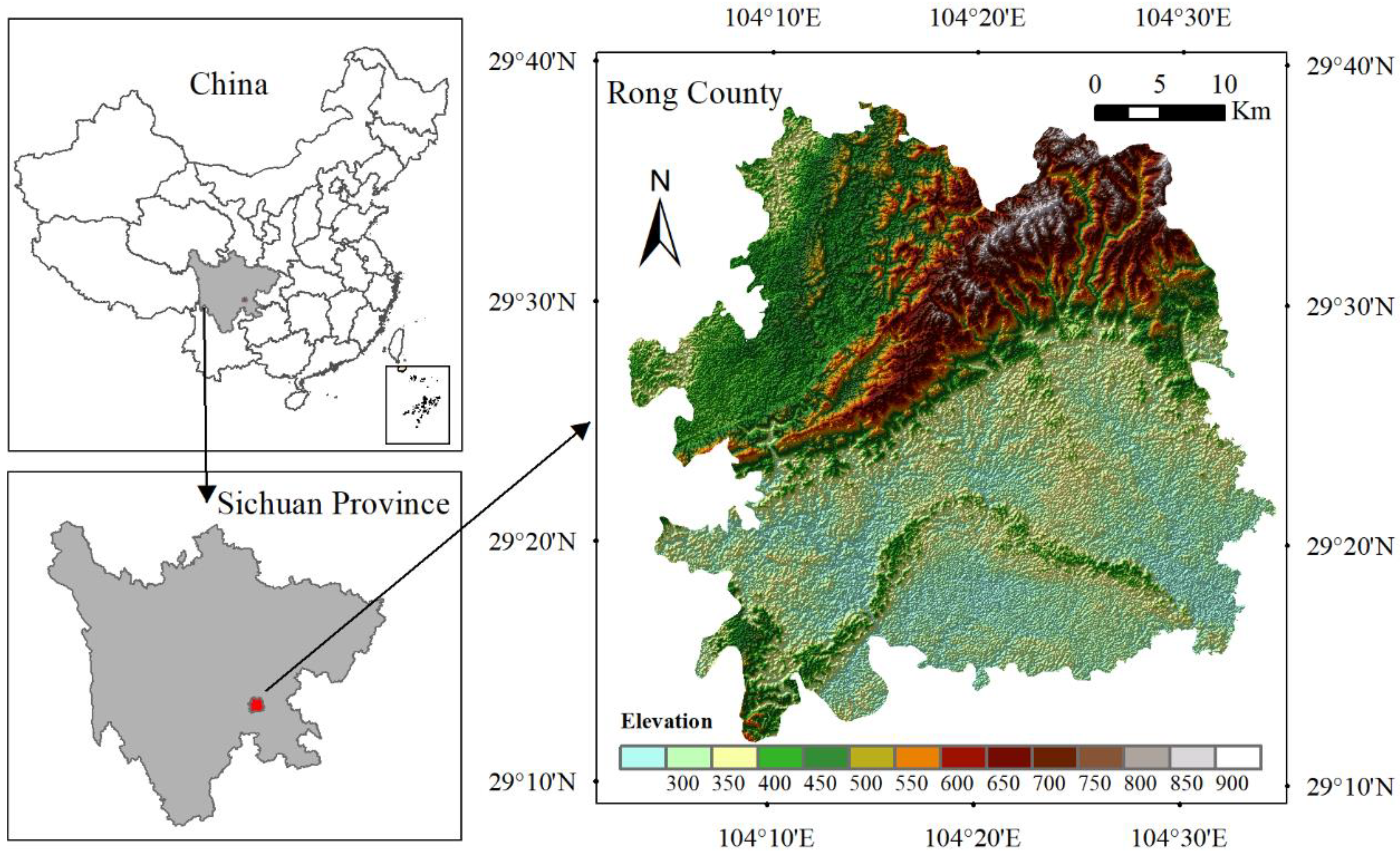
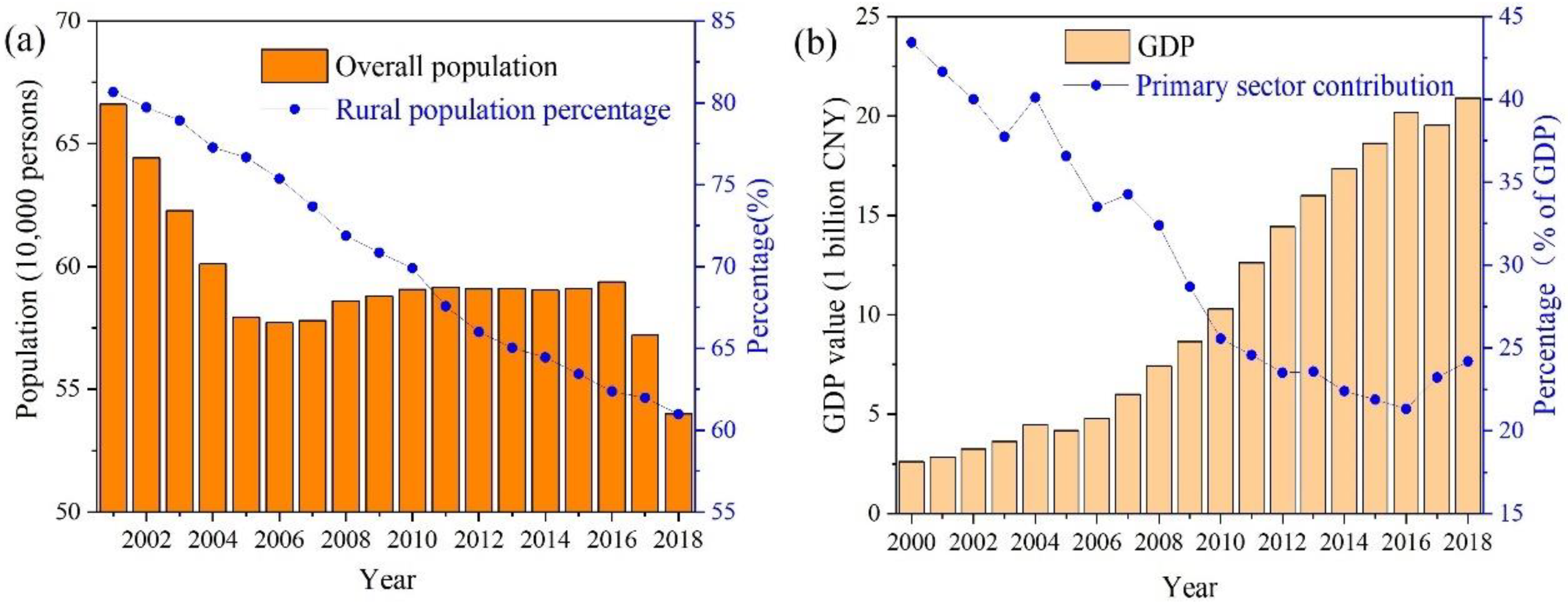

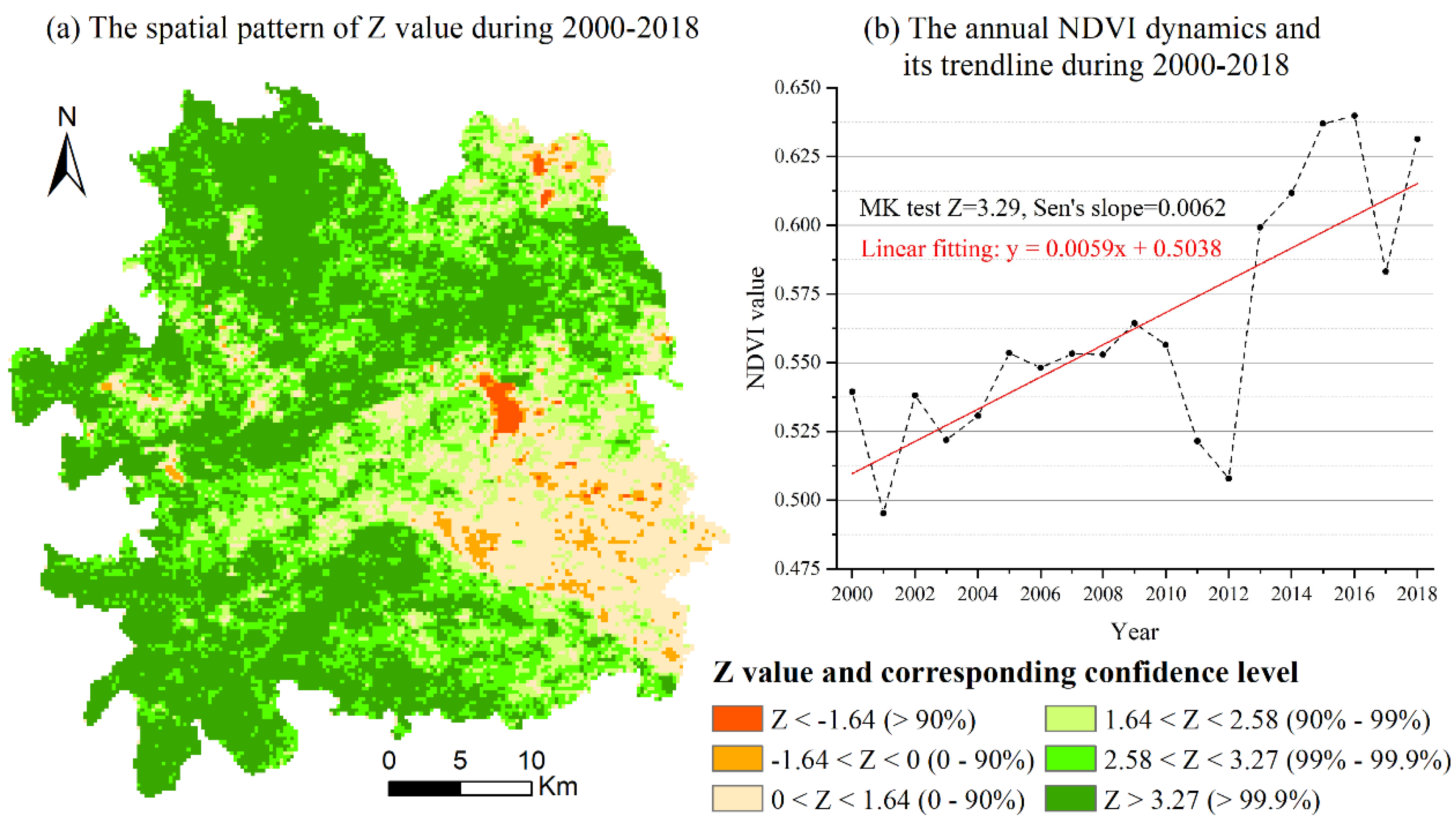

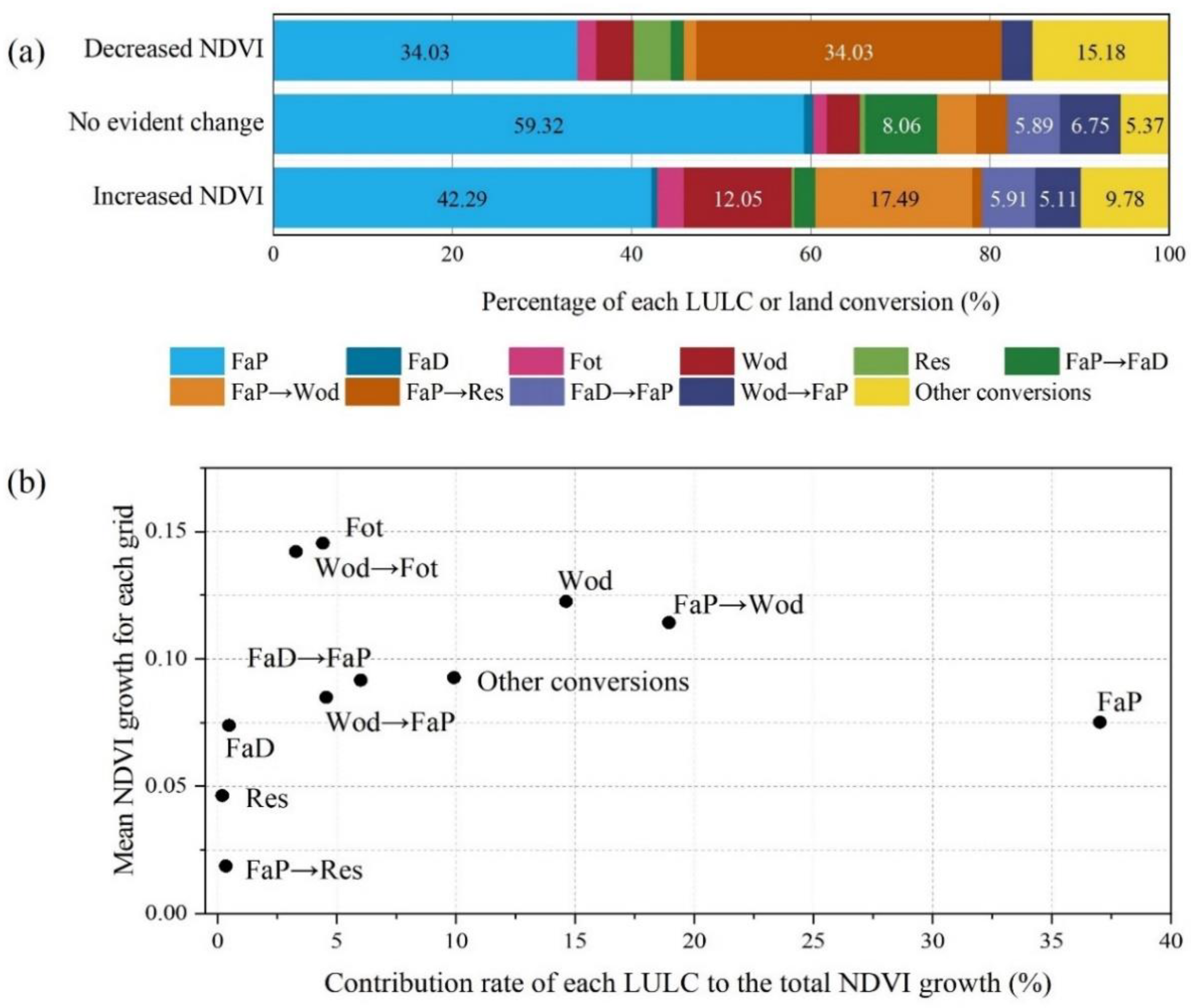
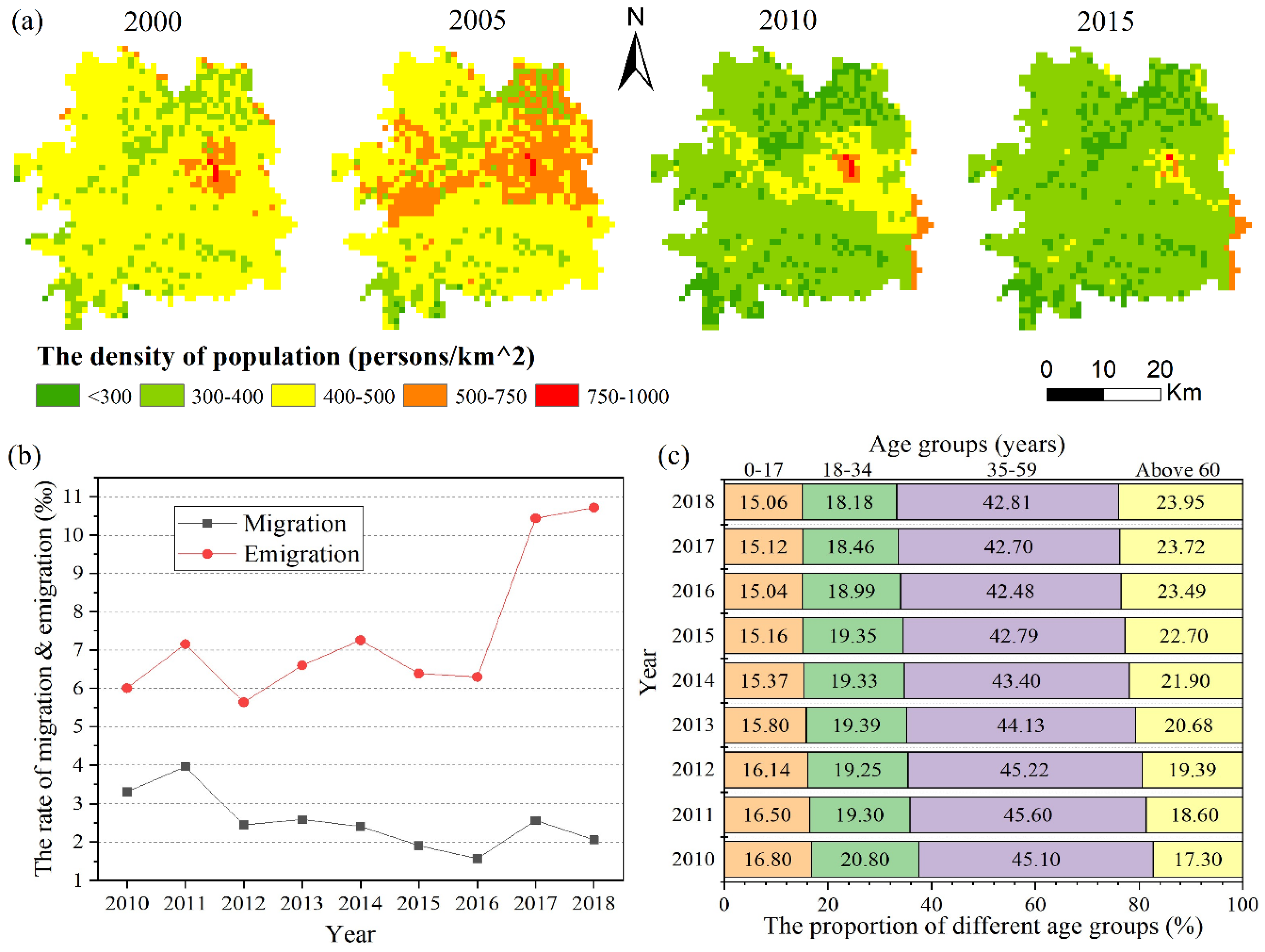
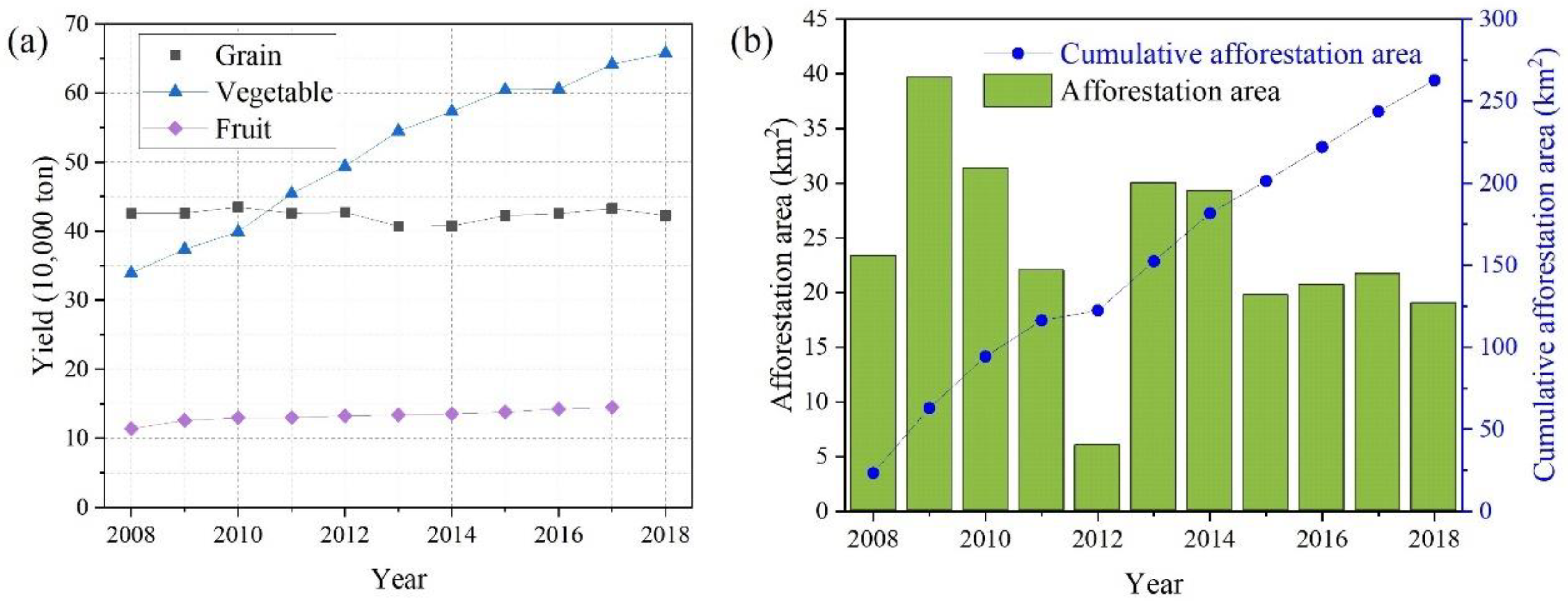
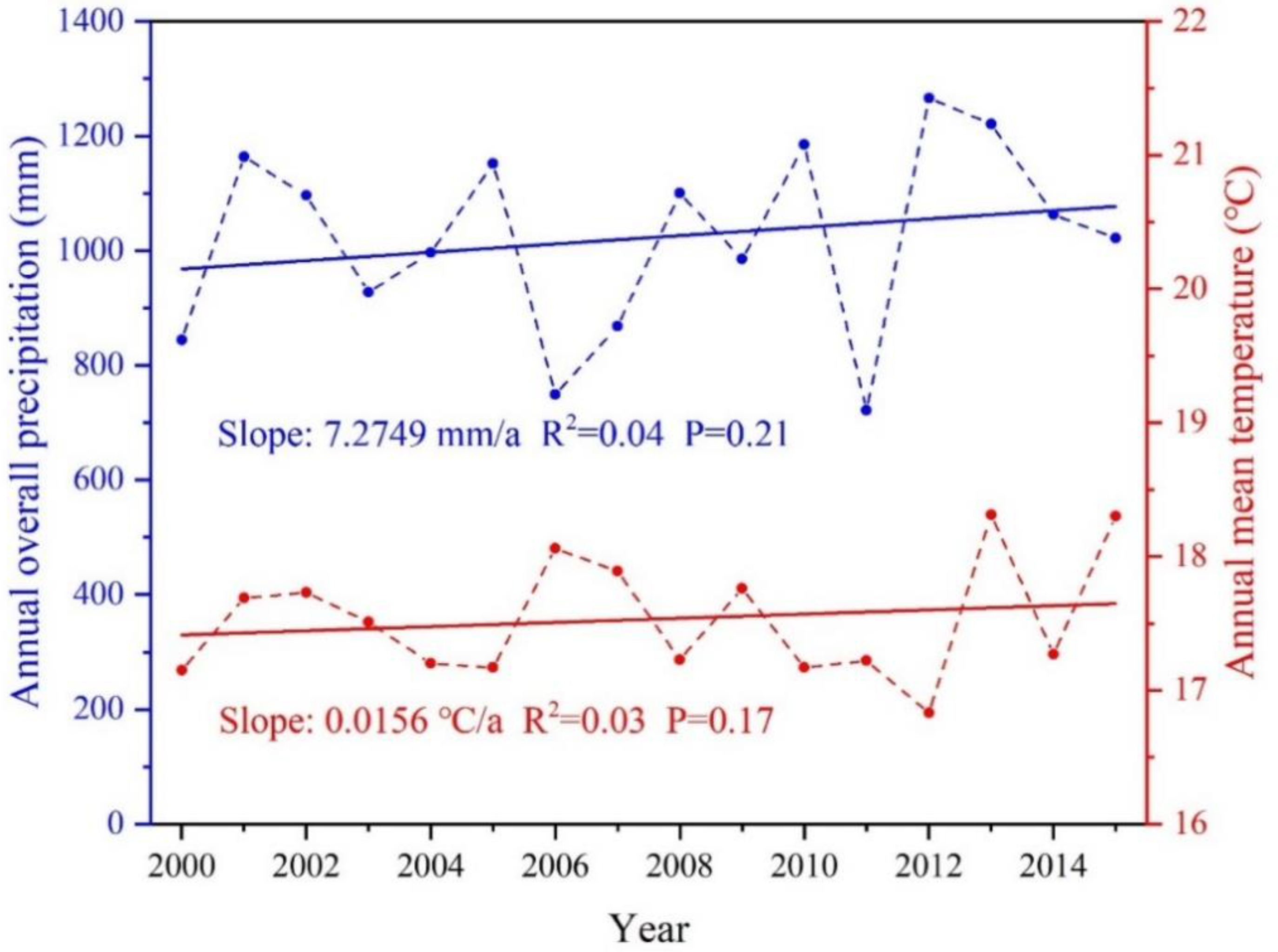
| Data Type | Time Periods | Data Sources | Usage |
|---|---|---|---|
| Landsat images | 2000, 2009, 2018 | USGS | Analysing LUCC |
| MODIS-NDVI | 2000–2018 | NASA’s Earth Observing System MODIS/Terra Vegetation Indices 16-Day L3 Global 250 m | Reflecting the vegetation condition and detecting its trends |
| Climatic datasets | 2000–2015 | National Centres for Environmental Information of National Oceanic and Atmospheric Administration (NOAA) | Analysing the changes of temperature and precipitation |
| Socio-economic statistical data | 2000–2018 | Government statistical bulletins and yearbooks | Analysing the changes of socio-economic development |
| Year | 2018 | Total (2000) | |||||||
|---|---|---|---|---|---|---|---|---|---|
| FaP | FaD | Fot | Wod | Gras | Res | WB | |||
| 2000 | FaP | 45.31 | 3.27 | 0.63 | 15.33 | 0.17 | 1.67 | 0.04 | 66.42 |
| FaD | 6.04 | 0.62 | 0.08 | 1.49 | 0.08 | 0.41 | 0.00 | 8.72 | |
| Fot | 0.35 | 0.00 | 2.60 | 1.36 | 0.00 | 0.09 | 0.00 | 4.40 | |
| Wod | 5.14 | 0.28 | 2.30 | 10.60 | 0.02 | 0.26 | 0.02 | 18.62 | |
| Gras | 0.00 | 0.02 | 0.00 | 0.17 | 0.69 | 0.04 | 0.00 | 0.92 | |
| Res | 0.32 | 0.01 | 0.01 | 0.03 | 0.00 | 0.40 | 0.00 | 0.78 | |
| WB | 0.05 | 0.00 | 0.00 | 0.00 | 0.00 | 0.00 | 0.08 | 0.14 | |
| Total (2018) | 57.22 | 4.20 | 5.62 | 28.98 | 0.96 | 2.87 | 0.14 | 100.00 | |
| Net gain in 2018 | −9.21 | −4.52 | 1.22 | 10.36 | 0.04 | 2.09 | 0.00 | ||
| Year | 2009 | Total (2000) | |||||||
|---|---|---|---|---|---|---|---|---|---|
| FaP | FaD | Fot | Wod | Gras | Res | WB | |||
| 2000 | FaP | 47.96 | 7.88 | 0.42 | 9.61 | 0.00 | 0.54 | 0.00 | 66.42 |
| FaD | 5.42 | 2.20 | 0.03 | 0.72 | 0.25 | 0.10 | 0.00 | 8.72 | |
| Fot | 0.56 | 0.00 | 2.68 | 1.15 | 0.00 | 0.01 | 0.00 | 4.40 | |
| Wod | 6.43 | 0.46 | 2.16 | 9.52 | 0.03 | 0.04 | 0.00 | 18.62 | |
| Gras | 0.00 | 0.15 | 0.00 | 0.09 | 0.66 | 0.01 | 0.00 | 0.92 | |
| Res | 0.43 | 0.04 | 0.01 | 0.02 | 0.01 | 0.26 | 0.00 | 0.78 | |
| WB | 0.05 | 0.01 | 0.01 | 0.00 | 0.00 | 0.01 | 0.07 | 0.14 | |
| Total (2009) | 60.85 | 10.73 | 5.30 | 21.13 | 0.96 | 0.96 | 0.07 | 100.00 | |
| Net gain in 2009 | −5.57 | 2.01 | 0.90 | 2.51 | 0.04 | 0.18 | −0.07 | ||
| Year | 2018 | Total (2009) | |||||||
|---|---|---|---|---|---|---|---|---|---|
| FaP | FaD | Fot | Wod | Gras | Res | WB | |||
| 2009 | FaP | 45.10 | 1.95 | 0.52 | 11.79 | 0.09 | 1.35 | 0.05 | 60.85 |
| FaD | 7.06 | 2.10 | 0.01 | 0.72 | 0.11 | 0.73 | 0.00 | 10.73 | |
| Fot | 0.28 | 0.01 | 3.06 | 1.88 | 0.00 | 0.07 | 0.00 | 5.30 | |
| Wod | 4.32 | 0.06 | 2.03 | 14.45 | 0.02 | 0.22 | 0.03 | 21.13 | |
| Gras | 0.00 | 0.03 | 0.00 | 0.12 | 0.73 | 0.07 | 0.00 | 0.96 | |
| Res | 0.45 | 0.06 | 0.00 | 0.02 | 0.00 | 0.42 | 0.00 | 0.96 | |
| WB | 0.01 | 0.00 | 0.00 | 0.00 | 0.00 | 0.00 | 0.06 | 0.07 | |
| Total (2018) | 57.22 | 4.20 | 5.62 | 28.98 | 0.96 | 2.87 | 0.14 | 100.00 | |
| Net gain in 2018 | −3.62 | −6.53 | 0.32 | 7.85 | 0.00 | 1.91 | 0.07 | ||
Publisher’s Note: MDPI stays neutral with regard to jurisdictional claims in published maps and institutional affiliations. |
© 2020 by the authors. Licensee MDPI, Basel, Switzerland. This article is an open access article distributed under the terms and conditions of the Creative Commons Attribution (CC BY) license (http://creativecommons.org/licenses/by/4.0/).
Share and Cite
Yu, Y.; Xu, T.; Wang, T. Outmigration Drives Cropland Decline and Woodland Increase in Rural Regions of Southwest China. Land 2020, 9, 443. https://doi.org/10.3390/land9110443
Yu Y, Xu T, Wang T. Outmigration Drives Cropland Decline and Woodland Increase in Rural Regions of Southwest China. Land. 2020; 9(11):443. https://doi.org/10.3390/land9110443
Chicago/Turabian StyleYu, Yi, Tingbao Xu, and Tao Wang. 2020. "Outmigration Drives Cropland Decline and Woodland Increase in Rural Regions of Southwest China" Land 9, no. 11: 443. https://doi.org/10.3390/land9110443
APA StyleYu, Y., Xu, T., & Wang, T. (2020). Outmigration Drives Cropland Decline and Woodland Increase in Rural Regions of Southwest China. Land, 9(11), 443. https://doi.org/10.3390/land9110443






